Can I Upload Gpx Maps to Humminbird 587ci Hd
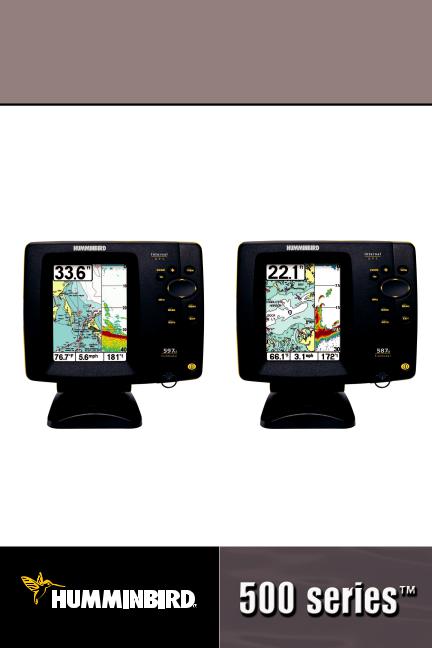
587ci and 597ci Combo
Operations Manual
531696-1_A

Cheers!
Thank yous for choosing Humminbird®, America's #1 name in fishfinders. Humminbird® has built its reputation by designing and manufacturing pinnacle-quality, thoroughly reliable marine equipment. Your Humminbird® is designed for trouble-complimentary utilise in even the harshest marine environment. In the unlikely event that your Humminbird® does crave repairs, we offer an exclusive Service Policy - free of accuse during the first year afterward purchase, and available at a reasonable rate after the 1-yr period. For complete details, see the separate warranty card included with your unit of measurement. We encourage y'all to read this operations manual carefully in gild to get full benefit from all the features and applications of your Humminbird® production.
Contact our Customer Resource Eye at either ane-800-633-1468 or visit our web site at www.humminbird.com.
WARNING! This device should not be used as a navigational aid to forbid collision, grounding, gunkhole damage, or personal injury. When the boat is moving, water depth may modify also quickly to allow time for you to react. Always operate the boat at very slow speeds if you suspect shallow water or submerged objects.
Warning! Disassembly and repair of this electronic unit of measurement should only exist performed by authorized service personnel. Any modification of the serial number or attempt to repairthe original equipment or accessories by unauthorized individualswill void the warranty.
WARNING! This product contains chemicals known to the Country of California to cause cancer and/or reproductive harm.
NOTE: Some features discussed in this manual require a separate purchase, and some featuresare only available on international models. Every efforthas been made to clearly identify those features. Please read the manual advisedly in guild to understand the full capabilities of your model.
Environmental COMPLIANCE Argument: Information technology is the intentionof Humminbird®to exist a responsible corporate citizen, operating in compliance with known and applicable environmentalregulations, and a good neighbor in the communitieswhere we make or sell our products.
WEEE DIRECTIVE: EU Directive 2002/96/EC "Wasteof Electricaland ElectronicEquipment Directive (WEEE)" impacts well-nigh distributors, sellers, and manufacturers of consumer electronics in the European Wedlock. The WEEE Directiverequires the producer of consumer electronics to take responsibility for the management of waste from their products to accomplish environmentally responsible disposal during the product life cycle.

WEEE compliance may not exist required in your locationfor electrical & electronicequipment (EEE), nor may it be required for EEE designed and intended every bit stock-still or temporary installation in transportation vehicles such equally automobiles, shipping, and boats. In some European Union member states, these vehicles are consideredoutside of the telescopic of the Directive, and EEE for those applications tin exist considered excluded from the WEEE Directive requirement.
This symbol (WEEE wheelie bin) on production indicates the production must not be disposed of with other household refuse. It must be disposed of and collectedfor recycling and recovery of waste EEE. Humminbird® will mark all EEE products in accordance with the WEEE Directive. Information technology is our goal to comply in the collection, treatment, recovery, and environmentally sound disposalof those products;however, these requirement do vary within European Spousal relationship member states. For more information virtually where you should dispose of your waste equipment for recyclingand recovery and/or your European Union fellow member state requirements, delight contact your dealer or distributorfrom
which your product was purchased.
ROHS Argument: Product designed and intended as a stock-still installation or function of a system in a vessel may be considered across the telescopic of Directive 2002/95/EC of the European Parliament and of the Council of 27 Jan 2003 on the restriction of the use of certain hazardous substances in electrical and electronicequipment.
Navionics® Gold, HotMaps™, and HotMaps Premium™ are registered trademarks of Navionics®. 500 Serial™, Fish ID+™, FishingGPS®, Humminbird®, RTS™, RTS Window™, Structure ID®, Selective Fish ID+®, WhiteLine™, UniMap™, and X-Press™ Menu are trademarked past or registered trademarks of Humminbird®.
© 2008 Humminbird®, Eufaula AL, United states. All rights reserved.

Table of Contents | |
| How Sonar Works | 1 |
| DualBeam Sonar ...................................... | ................................................................ 3 |
| How GPS and Cartography Work | four |
| What's On the Sonar Display | 6 |
| Understanding the Sonar Display ............................................................................ | viii |
| Real Time Sonar (RTS™) Window ............................................................................ | 9 |
| Freeze Frame and Active Cursor............................................................................. | ten |
| Lesser Presentation.............................................................................................. | 11 |
| Views | 13 |
| Sonar View ............................................................................................................ | 16 |
| Sonar Zoom View .................................................................................................. | 17 |
| Big Digits View ...................................................................................................... | 18 |
| Bird's Eye View ...................................................................................................... | xix |
| Chart View.............................................................................................................. | xx |
| Nautical chart/Sonar Philharmonic View........................................................................................ | 22 |
| View Orientation.................................................................................................... | 23 |
| Viewing Cartography ............................................................................................ | 23 |
| Introduction to Navigation | 26 |
| Waypoints, Routes, and Tracks ............................................................................. | 27 |
| Save, Edit, or Delete a Waypoint ........................................................................... | 28 |
| Navigate to a Waypoint or Position ........................................................................ | 30 |
| Add a Waypoint Targetor Trolling Grid .................................................................. | 31 |
| Relieve, Edit, or Delete a Route ................................................................................. | 33 |
| Save or Clear a Current Track................................................................................. | 34 |
| Edit, Delete, or Hibernate Saved Tracks ......................................................................... | 34 |
i

| Table of Contents | |
| Using Your 500 Series™ Control Head | 36 |
| Key Functions | 37 |
| Power/LIGHT Key ............................................................................................. | 37 |
| VIEW Fundamental ............................................................................................................. | 37 |
| INFO Central ............................................................................................................... | 38 |
| MENU Central ........................................................................................................... | 38 |
| 4-Style Cursor Control Key ................................................................................. | 39 |
| MARK Fundamental............................................................................................................. | twoscore |
| GOTO Cardinal............................................................................................................... | 40 |
| ZOOM (+/-) Fundamental..................................................................................................... | forty |
| Exit Key ............................................................................................................... | 41 |
| Multi-Media Menu (MMC)/SD Slot | 42 |
| Adding Maps to Your Fishfinder .......................................................................... | 42 |
| Exporting Navigation Data ................................................................................... | 43 |
| Powering On the Unit of measurement | 44 |
| The Bill of fare System | 45 |
| Get-go-Up Options Menu | 46 |
| Normal Operation ................................................................................................. | 47 |
| Simulator ............................................................................................................. | 47 |
| System Status ..................................................................................................... | 49 |
| Self Exam................................................................................................................. | 49 |
| Accompaniment Test....................................................................................................... | 50 |
| GPS Diagnostic View ........................................................................................... | 51 |
| X-Press™ Menu | 52 |
ii

| Table of Contents | |
| Main Carte | 53 |
| Quick Tips for the Principal Menu .................................................................................... | 54 |
| User Fashion (Normal or Avant-garde) .............................................................................. | 55 |
| Sonar Ten-Press™ Bill of fare (Sonar views merely) | 57 |
| Sensitivity ................................................................................................................ | 58 |
| Upper Range (Advanced: Sonar and Big Digitsviewsonly).............................................. | 59 |
| Lower Range .......................................................................................................... | 60 |
| Chart Speed ............................................................................................................ | 61 |
| Abolish Navigation (merely when Navigating) ................................................................ | 61 |
| Navigation X-Press™ Carte (Navigation views only) | 62 |
| Waypoint [Proper noun] (Only with an active cursor on a waypoint) ...................................... | 63 |
| Cursor To Waypoint (Chart or Combo View only) ........................................................ | 64 |
| Save Electric current Track .................................................................................................. | 64 |
| Clear Electric current Track .................................................................................................. | 65 |
| Salve Current Road (simply when Navigating) .............................................................. | 65 |
| Skip Next Waypoint (only when Navigating) .............................................................. | 66 |
| Abolish Navigation (just when Navigating) ................................................................ | 66 |
| Remove Target (only if Target is Active) ...................................................................... | 67 |
| Remove Filigree (only if Grid is Active).............................................................................. | 67 |
| Sonar Window (Philharmonic View just).............................................................................. | 67 |
| Waypoint [Name] (Well-nigh recently-created waypoint) .................................................... | 68 |
| Alarms Carte Tab | 69 |
| Depth Alarm ............................................................................................................ | 70 |
| Fish ID Alarm............................................................................................................ | 70 |
| Low Battery Alarm .................................................................................................. | 71 |
| Temp. Alarm ............................................................................................................ | 71 |
| Off Course Warning...................................................................................................... | 72 |
| Arrival Alarm ............................................................................................................ | 72 |
| Drift Alarm................................................................................................................ | 73 |
| Alarm Tone .............................................................................................................. | 74 |
iii

| Tabular array of Contents | |
| Sonar Menu Tab | 75 |
| Fish ID+™ ............................................................................................................. | 76 |
| Fish ID Sensitivity ................................................................................................. | 77 |
| Existent Time Sonar (RTS™) Window ........................................................................ | 77 |
| Bottom View ......................................................................................................... | 78 |
| Zoom Width ......................................................................................................... | 78 |
| Depth Lines (Avant-garde) .......................................................................................... | 79 |
| Surface Clutter (Advanced)...................................................................................... | 80 |
| Dissonance Filter (Advanced) ............................................................................................ | 81 |
| Max Depth (Avant-garde) ............................................................................................ | 81 |
| Water Blazon (Avant-garde) ............................................................................................ | 82 |
| Navigation Bill of fare Tab | 83 |
| Current Track......................................................................................................... | 84 |
| Saved Tracks ......................................................................................................... | 84 |
| Waypoints ............................................................................................................. | 86 |
| Routes ................................................................................................................... | 88 |
| Nautical chart Orientation ................................................................................................. | 89 |
| Chart Item Level ................................................................................................. | xc |
| Map Borders ......................................................................................................... | 91 |
| Lat/Lon Grid........................................................................................................... | 91 |
| Spot Soundings ...................................................................................................... | 92 |
| Shaded Depth ....................................................................................................... | 92 |
| Chart Select........................................................................................................... | 92 |
| North Reference ................................................................................................... | 93 |
| Waypoint Decluttering (Advanced).......................................................................... | 93 |
| Filigree Rotation ......................................................................................................... | 94 |
| Trackpoint Interval ............................................................................................... | 94 |
| Rail Min Distance(Avant-garde) .............................................................................. | 95 |
iv

| Tabular array of Contents | |
| Map Datum (Advanced) ............................................................................................ | 95 |
| Gear up Simulation Position (Advanced) .......................................................................... | 96 |
| Set up Map Beginning (Advanced)........................................................................................ | 97 |
| Course Projection Line ........................................................................................... | 97 |
| Clear Map Offset (Avant-garde) .................................................................................... | 98 |
| Export All Nav Information (Avant-garde) ................................................................................ | 98 |
| Delete All Nav Data (Advanced) ................................................................................ | 99 |
| Setup Menu Tab | 100 |
| Units - Depth.......................................................................................................... | 101 |
| Units - Temp (International merely) .............................................................................. | 101 |
| Units - Distance...................................................................................................... | 101 |
| Units - Speed.......................................................................................................... | 102 |
| User Manner ............................................................................................................ | 102 |
| Language (International just).................................................................................... | 102 |
| Triplog Reset ......................................................................................................... | 103 |
| Restore Defaults ................................................................................................... | 103 |
| Select Readouts (Advanced, Sonar View only) .......................................................... | 104 |
| Depth Starting time (Advanced).......................................................................................... | 105 |
| Temp. Offset (Advanced, with Temp/Speed only) ........................................................ | 106 |
| Speed Calibration (Advanced, with Temp/Speed only)................................................ | 106 |
| Local Time Zone (Advanced) .................................................................................... | 107 |
| Daylight Saving Fourth dimension (Avant-garde)............................................................................ | 107 |
| Position Format (Advanced) .................................................................................... | 108 |
| Fourth dimension Format (Avant-garde, International just)................................................................ | 108 |
| Engagement Format (Advanced, International only)................................................................ | 109 |
| NMEA Output (Advanced) ...................................................................................... | 109 |
| Sonar .................................................................................................................... | 110 |
v

| Tabular array of Contents | |
| Views Carte Tab | 111 |
| Troubleshooting | 112 |
| Fishfinder Doesn't Power Up .............................................................................. | 112 |
| Fishfinder Defaults to Simulator with a Transducer Fastened.......................... | 112 |
| Display Problems ............................................................................................... | 113 |
| Finding the Cause of Noise ............................................................................... | 114 |
| 500 Series™ Fishfinder Accessories | 115 |
| Specifications | 116 |
| Glossary | 117 |
| Contact Humminbird® | 133 |
Annotation: Entries in this Table of Contents which list (International Merely) are only available on products sold exterior of the U.S. past our authorized International Distributors. It is important to annotation that products sold in the U.S. are not intended for resale in the international market. To obtain a listing of authorized International Distributors, delight visit our website at www.humminbird.com or contact our Customer Resource Center at 1-800-633-1468 to locate the distributornearest y'all.
NOTE: Entries in this Table of Contents which listing (with Temp/Speed merely) require the purchase of split up accessories. You lot can visit our website at www.humminbird.com to guild these accessories online or contact our Customer Resources Eye at ane-800-633-1468.
Notation: Some features discussed in this manual require a separate purchase, and some features are only available on international models. Every effort has been made to clearly identify those features. Please read the manual carefully in order to understand the total capabilities of your model.
vi

How Sonar Works
Sonar technology is based on audio waves. The 500 Series™ Fishfinder uses sonar to locate and ascertain construction, lesser contour and composition, as well every bit depth directly below the transducer.
Your 500 Series™ Fishfinder sends a audio wave betoken and determines distance by measuring the time betwixt the manual of the sound wave and when the sound wave is reflected off of an object; it then uses the reflected signal to translate location, size, and composition of an object.
Sonar is very fast. A sound wave can travel from the surface to a depth of 240 ft (70 k) and back again in less than 1/iv of a second. It is unlikely that your gunkhole can "outrun" this sonar signal.
SONAR is an acronym for Sound and NAvigation Ranging. Sonar utilizes precision sound pulses or "pings" which are emitted into the water in a teardrop-shaped beam.
The sound pulses "repeat" back from objects in the water such every bit the bottom, fish, and other submerged objects. The returne d echoes are displayed on the LCD screen. Each time a new echo is received, the quondam echoes are moved across the LCD, creating a scrolling consequence.
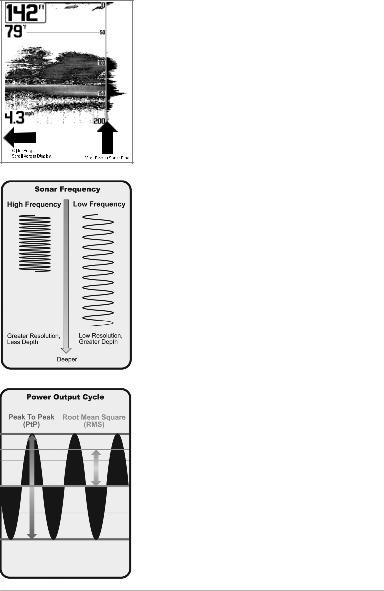
When all the echoes are viewed next, an easy to translate "graph" of the lesser, fish, and construction appears.
The audio pulses are transmitted at various frequencies depending on the application. Very loftier frequencies (455 kHz) are used for greatest definition but the operating depth is limited. High frequencies (200 kHz) are commonly used on consumer sonar and provide a good residual betwixt depth performance and resolution. Low frequencies (83 kHz) are typically used to accomplish greater depth capability.
The power output is the amount of energy generated by the sonar transmitter. It is commonly measured using two methods:
• Root Mean Foursquare (RMS) measures power output over the entire transmit cycle.
• Tiptop to Elevation measures power output at the highest points.
The benefits of increased power output are the power to notice smaller targets at greater distances, power to overcome noise, better high speed performance, and enhanced depth capability.
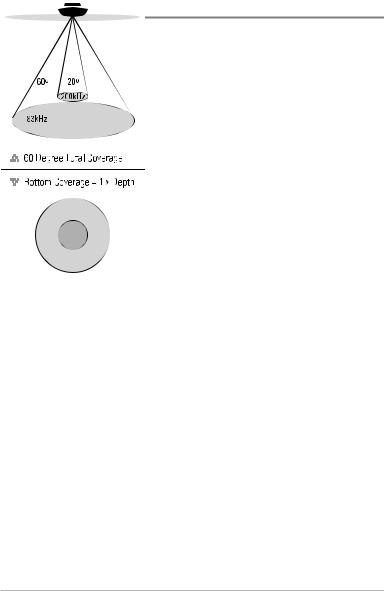
DualBeam Sonar
Your 500 Series™ Fishfinder uses a 200/83 kHz DualBeam sonar system with a broad (60°) area of coverage. DualBeam sonar is optimized to show the greatest bottom definition using a narrow (20°) axle nevertheless can all the same indicate fish found in the wide (60°) axle when the Fish ID+™ feature is turned on. DualBeam is platonic for a wide range of conditions - from shallow to very deep water in both fresh and salt h2o. Depth capability is affected by such factors as gunkhole speed, wave action, bottom hardness, water conditions, and transducer installation.
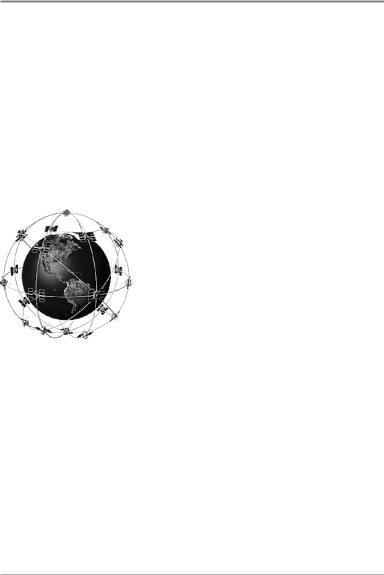
How GPS and Cartography Work
Your 500 Series™ Fishfinder too supports GPS and chartplotting. It uses GPS and sonar to determine your position, display it on a grid, and provide detailed underwater data. The Global Positioning System (GPS) is a satellite navigation organisation designed and maintained by the U.S. Department of Defense. GPS was originally intended for military machine employ; however, civilians may also take reward of its highly accurate position capabilities, typically within +/- 10 meters, depending on conditions. This means that 95% of the time, the GPS receiver will read a location within 10 meters of your actual position. Your GPS Receiver also uses information from WAAS (the Wide Area Augmentation
System), EGNOS (the European Geostationary Navigation Overlay Service), and MSAS (the MTSAT Satellite Augmentation System) satellites if they are bachelor in your surface area.
GPS uses a constellation of 24 satellites that continually send radio signals to the earth. Your present position is determined by receiving signals from up to 16 satellites and measuring the altitude from the satellites.
All satellites broadcast a uniquely coded bespeak once per second at exactly the same time. The GPS receiver on your boat receives signals from satellites that are visible to it. Based on time
differences between each received signal, the GPS receiver determines its distance to each satellite. With distances known, the GPS receiver mathematically triangulates its ain position. With once per second updates, the GPS receiver then calculates its velocity and bearing.
| How GPS and Cartography Work | four |

The GPS Receiver included with your 500 Serial™ Fishfinder allows you to combine easy-to-apply FishingGPS® chartplotter and navigation capabilities with advanced fishfinding.
The following GPS functionality is currently supported by the 500 Series™ Fishfinder when it is connected to the included GPS receiver:
• View current position
• View current rails (breadcrumb trail)
• View precision speed and heading from your GPS receiver
• Salve tracks, waypoints, and routes
• Travel a route and navigate from ane waypoint to the next.
Your 500 Series™ supports Navionics® Gold, HotMaps™ and HotMaps™
Premium on MMC or SD menu media. You can insert optional-purchase cards in the (MMC)/SD slot on your control head to access additional detailed maps. See Multi-Media Carte (MMC)/SD Slot for more data.
NOTE: Your 500 Serial™ supports Navionics® Golden, HotMaps™, and HotMaps™ Premium. Your 500 Series™ does not support Navionics® Classic Charts or Platinum™ Cartography.
Your unit also comes with a built-in UniMap™ with a more detailed map of North America (Domestic models) or a more detailed map of Europe and Southeast Asia, including Australia and New Zealand (International models).
Your 500 Series™ uses the GPS Receiver to determine the position of the boat automatically, and it uses the zoom level settings on a detail view to select the best chart to display. See Chart View: Viewing Cartography for more information.
| 5 | How GPS and Cartography Work |
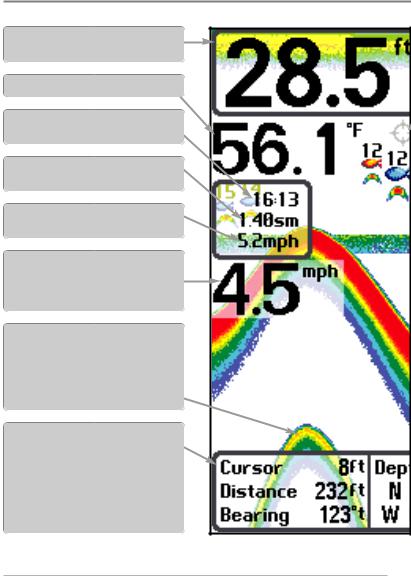
What'south On the Sonar Brandish
The 500 Series™ Fishfinder can display a diversity of useful information about the
Depth - water depth; can be gear up to alarm when the water becomestoo shallow.
Temperature - water surface temperature.
Timer - Elapsed time with Temp/Speed
Accessory or GPS Receiver.
Distance - Distance traveled with Temp/Speed
Accessory or GPS Receiver.
Average Speed - Average speed reading with
Temp/Speed Accessory or GPS Receiver.
Speed - if a Temp/Speed accompaniment or GPS Receiver is fastened, the Fishfinder tin display the speed of the gunkhole and can continue a Triplog of nautical or statutemiles traveled.
Second Sonar Return - when the sonar bespeak bouncesbetweenthebottomand thesurface ofthe water and backagain. Use the appearance of the 2nd returnto determine bottomhardness. Difficult bottomswillshowa strongsecondreturn,whilesoft bottomswillshowa veryweakone ornoneat all.
Cursor Dialog Box - indicates cursor depth on the display and the depth of the bottom directly beneath the cursor. The Latitude and Longitude of the cursor position, the distance to travel to the cursor position and the begetting to the cursor position is shown with a GPS receiver. A waypoint can exist marked at the cursor position for later retrieval and use with a GPS receiver.
NOTE: Entriesin this view that list (with Temp/Speedor GPS Receiver)are availableif either device informationfrom the GPS receiverwill exist displayedon the view.
| What's On the Sonar Display | 6 |
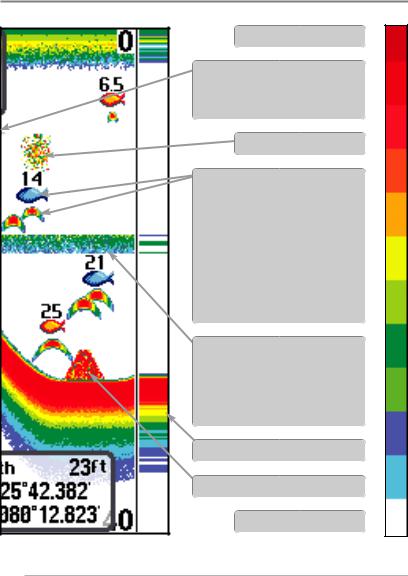
area under and next to your boat, including the following items:
High Sonar Intensity Return 
Cursor - bachelor in Freeze Frame and can be positioned in the Sonar View to provide depth of a sonar return and bottomdepthbelow the cursor.
Allurement Brawl
Fish - the Fishfinder displays fish every bit arches and/or fish icons, and can be prepare to alarm when a fish of a sure size is detected. When a target is detected, a Fish ID+™ symbol appears on the display with the depth displayed above it. The size of the symbol indicates the intensity of the sonar return. The unit will clearly prove schools of Bait Fish equally "clouds" of different shapes and sizes, depending on the number of fish and boat speed.
Thermoclines - layers of water with different temperatures that appear at different depths and differenttimes of the year. A thermocline typically appears every bit a continuous band of many colors moving across the display at the aforementioned depth.
RTS (Real Time Sonar) Window™
Structure - where fish may exist hiding.
Low Sonar Intensity Return 
is connected to the 500 Series™ Fishfinder.If both devices are connected,then but the
| vii | What'south On the Sonar Display |
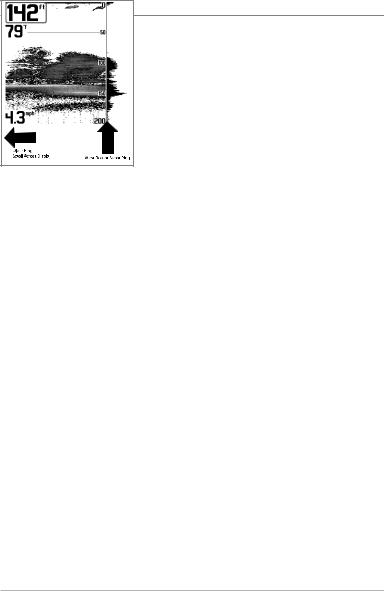
The returned due south onar echoes are di splayed on the screen. As a new echo is received, the historicaldata scrolls across the screen.
Understanding the Due southonar Display
It is im portant to u nderstand thursday e sign ificance of the display. The display does not prove a literal 3- dimensional re presentation o f what is under the water. Each vertical band of dat a received by the control head and plotted on the brandish represents something that was detected by a sonar return at a particular time. As both the boat and the targets (fish) may be moving, the returns are simply showing a pa rticular s egment of tim e w hen o bjects were detected, no t exactly wh ere those o bjects are in relation to other objects shown on the display.
| What's On the Sonar Brandish | 8 |

Existent Time Southwardonorthar (RTS™) Windowestward
A Real Time Sonar (RTS™) Window appears on the right side of the display in the Sonar View only. The RTS Window™ updates at the fastest rate possible for depth conditions and shows merely the returns from the bottom, construction, and fish that are within the transducer axle . The RTS Wind ow™ plots the depth and intensity of a sonar return (run across Sonar Menu Tab: RTS Window ™).
The Narrow RTS W indow™ indicates the sonar intensity through the use of colors. Cerise indicates a stiff render and blueish indicates a weak render. The depth of the sonar return is indicated by t he ver tical placement of the return on the display depth scale.
The Broad R TS Window™ indicates t he so nar i ntensity through the u se of a ba r graph. The length of the plotted r eturn indicates whether the return is weakor strong. The depth of the sonar return is in dicated by th e vertical p lacement of th e return o due north the d isplay d epth
| scale. The Broad RT | S |
| Window™ does n ot us | e |
| grayscale. |
| ix | What'southward On the Sonar Display |

Freeze Frame and Active Cursor
Freeze Frame & Active Cursor - Press anyarrow on the four-Mode Cursor Control key, and the screen will freeze and a cursor will be displayed. Use the iv-Manner Cursor Command key to 1000 ove the cursor over a sonar return, and the depth of the sonar return volition be displayed at the lesser of the screen in the cursorinformation box.
Instant Image Update - You lot can change a variety of sonar menu settings (such as Sensitivity or Upper Range), and the adjustments volition be shown instantly on the screen. When combined with the Freeze frame characteristic, you can arrange and see the effects of many different sonar settings speedily and easily.
The RTS Window™ continues to update in Freeze Frame. Pressing EXIT volition exit Freeze Frame, and the display will start to curl. Freeze Frame is available in the Sonar and Sonar Zoom Views.
| What'southward On the Sonar Brandish | 10 |
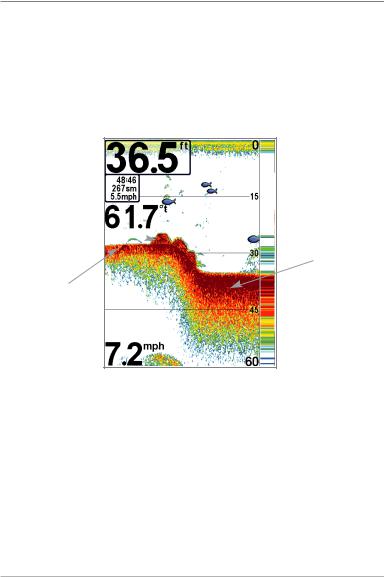
Bottom Presentation
As the gunkhole moves, the unit of measurement charts the changes in depth on the brandish to create a profile of the Bottom Contour. The blazon of bo ttom tin can be determined from the return charted on the brandish. A Hard Bottom such as compacted sediment or flat stone appears as a thinner line across the display. A Soft Bottom such as mud or sand appears equally a thicker line beyond the display. Rocky Bottoms have a broken, random appearance.
Bottom Contour Profile with RTS Window™
Rocky Bottom
Soft Bottom
Hard Lesser
The sonar returns from the bott om, structure, and fish can be represented as either WhiteLine ™ or Structure ID®. Run into Sonar Menu Tab: Bottom View for details on how to fix the bottom view.
| 11 | What'south On the Sonar Brandish |
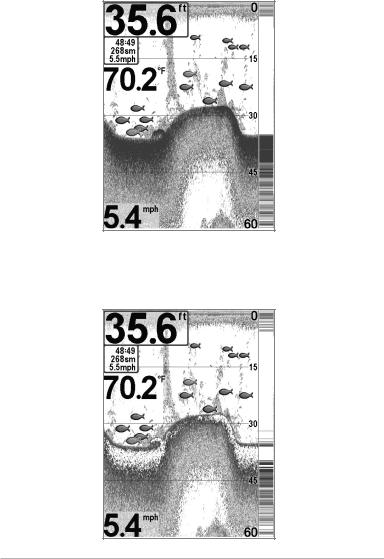
Structure ID® represents weak returns in bluish and potent returns in red.
WhiteLine ™ highlights the s trongest sonar r eturns in white, res ulting in a distinctive outline.This hasthe benefit of clearly defining the lesser on the display.
| What's On the Sonar Display | 12 |
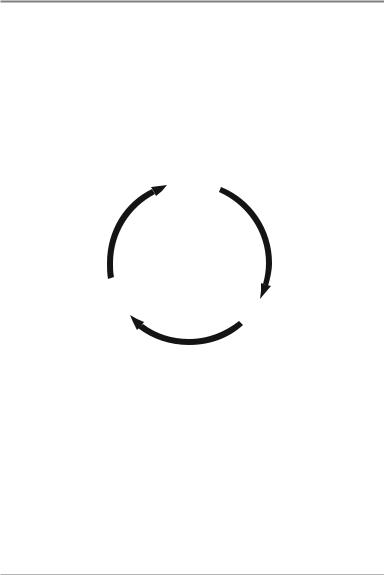
Views
The sonar and navigation information from your Fishfinder is displayed on your screen in a multifariousness of easy-to-read views. At that place are many views available on your Fishfinder. When yous press the VIEW key, the display cycles through the available views on your screen. When y'all printing the Go out key, the brandish cycles through the available views in reverse order.
When y'all outset power upwards the command head, Sonar View will be the default view.
You can display and hide any view to conform your fishing preferences.
Cha tr iVwe
riB d's eye iVwe
GPS
aid gnost ci iVwe
Sona r
View
Sonar Zoom
View
giB iD ig st iVwe
Sel f eT st iVwe
Ac se sor y eT ts View
Note: When you modify whatever menu settings that affect the sonar,the view will update immediately. Youdon't have to exit the bill of fare to apply the modify to the screen.

To customize your views rotation:
You tin choose which views are hidden or visible in your view rotation.
i. Press the Chiliad ENU key t wice t o acc ess th e tab bed Main Menu, so press the Right Cursor cardinal until the Views tab is selected.
2. Press the UP or DOWN Cursor keys to select a View.
3. Press the LEFT or Correct Cursor keys to alter the status of the view from Hidden to Visible or vice versa.
To alter the Digital Readouts:
Each view displays digital readout information (such equally sp eed or time), which varies with the view selected, the accessory attached, and whether or not you are navigating. The digital readouts on the Sonar View can be customized. See
Setup Menu Tab: Select Readouts for more information.
one. Press the M ENU central t wice t o acc ess th due east tab bed Principal Menu, and then press the RIGHT Cursor key until the Setup tab is selected.
ii. Press the DOWN cardinal to highlight Select Readouts, and printing the RIGHT Cursor key to admission the Select Readouts submenu.
Note: If the Select Readouts option does not appear under theSetup tab, alter the User Style to Advanced.
3. Printing the UP or Down Cursor keys to select a Readout position, then printing the Correct or LEFT Cursor keys to choose what will be displayed in that position. To hide the data window, select Off. (Form, Navigation, Off, Position, Speed, Temperature, Time+Date, Triplog, Voltage)

The available views are shown hither and described on the following pages.
| Sonar views: | Navigation views: |
| Sonar View | Bird'south Eye View |
| Sonar Zoom View | Chart View |
| Big Digits View | Chart/Sonar Combo View |
| Self Test View | |
| (see Start-Up Options Card) | |
| Accessory Test View | |
| (run into First-Up Options Menu) | |
| GPS Diagnostic View | |
| (see Start-Upward Options Carte) |
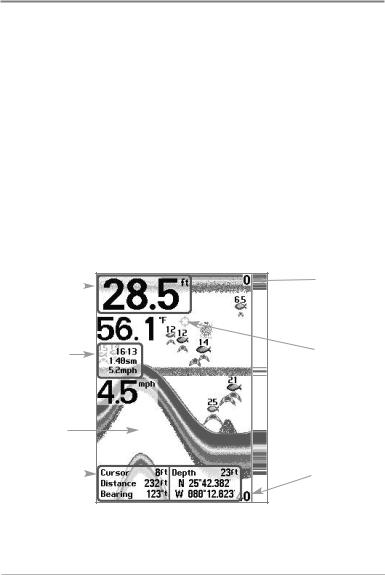
Sonar View
Sonar View presents a historical log of sonar ret urns. The most recent sonar returns ar e char ted on the right side of the wi ndow. As new information i s received, the historical information scrolls left across the brandish.
• Upper and Lower Depth Range numbers indicate the altitude from the surface of the water to a depth range sufficient to show the bottom.
• Depth is automatically selected to continue the bottom visible on the brandish, although you can adjust information technology manually every bit well(meet Sonar X-Press™ Menu).
• Digital Readouts shown on the display will alter based on the Select Readouts settings or t he optional-purchase accessories attached (see
Setup Menu Tab: Select Readouts).
• Freeze Frame - Use the four-Way Cursor Control central to freeze the display and move the cursor over a sonar return. The depth of the sonar return will be displayed at the lesser of thescreen in the cursor information box.
Sonar View
| Depth | Upper Depth | |
| Range | ||
Temperature 
Cursor
Triplog
Speed
 RTS Window™
RTS Window™
Sonar History
Window
| Cursor | Lower Depth | |
| Dialog Box | Range |
NOTE: If the Depth number is flashing, it ways that theunit is havingtroublelocating the bottom. This usually happens if the water is besides deep, the transduceris out of the water, the boat is moving also fast, or for any other reasonthat the unitcan't accurately receive continuous data.
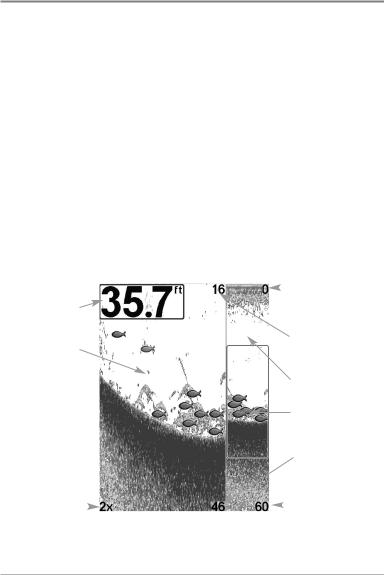
Sonar Zoom View
Sonar Zoom View provides a magnified view of the lesser and construction. The Sonar Zoom View makes it easier to see sep arate and then nar return southward that would usually be displayed close together, such equally t hose caused past fish su spended shut to the bottom or inside structure.
• The Zoom Level, or magnification, is displayed in the lower left corner of the d isplay. Press the + o r - Z OOM keys to increase or d ecrease the zoom level.
• The Z oomed View is dis played on the le ft sid e o f th e screen. Every bit the depth changes, the zoomed view updates automatically.
• The Full Range View is displayed on the right side of the screen. The Total Range View includes the Zo om Preview Box, which sho ws where the zoomed view is in relation to the full range view.
• The Upper and Lower Depth Range numbers indicate the high and depression range of the water which is being viewed.
| Sonar Zoom View | |||||||
| Upper Depth Range, | |||||||
| Depth | Total Range View | ||||||
| Upper Depth Range, | |||||||
| Zoomed View | Zoom View | ||||||
| Full Range View | |||||||
| Zoom Preview Box | |||||||
| Lower Depth Range, | |||||||
| Zoom View | |||||||
| Lower Depth Range, | |||||||
| Zoom Level | Full Range View | ||||||
| Digital depth is displayed in the upper left manus corner. | |||||||
| The digital readouts in the Sonar Zoom View cannot | |||||||
| be customized; therefore, data such every bit water | |||||||
| temperature and voltage are unavailable in the Sonar | |||||||
| Zoom View. | |||||||
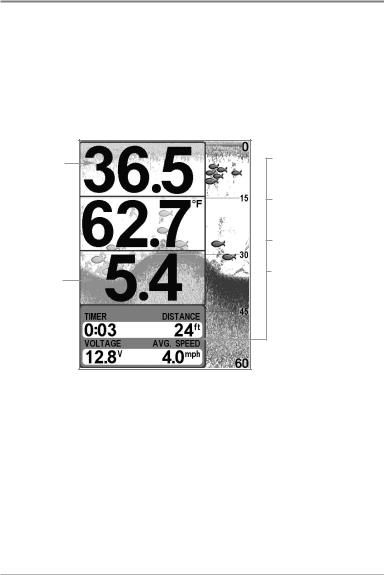
Large Digits View
Large Digits V iew provides digital dat a in a large, easy-to-see format. Depth is always displayed. Readouts for temperature, speed, and Triplog information are displayed automatically if t he appropriat east a ccessory is connected to the arrangement. The Triplog shows distance traveled, average speed, and time elapsed since the Tr iplog w equally final reset. The digital reado uts in t he Big Digits View cannot be customized.
Big Digits View
Depth
Temperature 
Speed
Timer shows the
time elapsed since Triplog was concluding reset
Distance is the altitude traveled since the Triplog was final reset
Voltage displays the battery voltage
Boilerplate Speed shows the speed since the Triplog was final reset
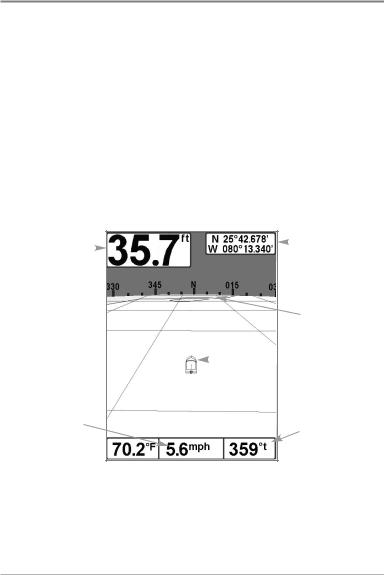
Bird's Eye View
Bird'due south Center View shows a 3D perspective view of the track and the chart's state contour from a point to a higher place andbehind theboat (the eye point). As the boat turns, the middle pointmoves to follow the boat.
When you press the 4-WAY Cursor ontrolC primal in theBird'south Eye View, the position of the eye betoken will shift. This allows youto move and turn the center indicate so that you can look off to thesides, or fifty-fifty behind the boat. Pressing the Correct or LEFT arrow keys on the iv-Mode Cursor Control key turns the eye point right or left, while pressing the Upwardly pointer key moves the eye signal forward, and pressing the DOWN pointer fundamental moves the heart betoken backward.
Pressing the Get out key moves the eye indicate dorsum to its original position backside and to a higher place the boat.
Bird's Eye View
| Depth | Breadth and | ||||
| Longitude | |||||
| Position | |||||
| of Boat | |||||
| Land Contours | |||||
| Boat Icon | |||||
| Speed of Boat | Bearing of Boat |
| with Respect to | |
| True Northward |
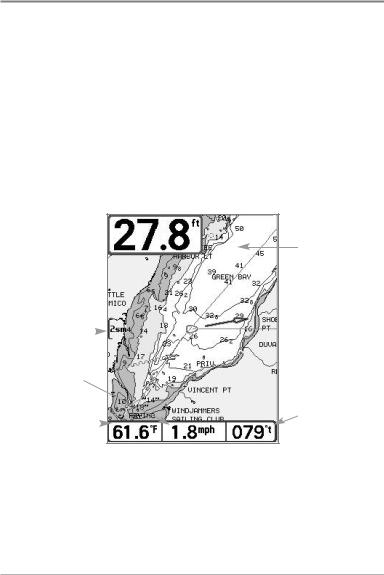
Chart View
Nautical chart View shows cartography fr om t he bu ilt-in U niMap™ or an optional MMC/SD map for the area surrounding your current position. The electric current track (also known every bit t he position hist ory or b readcrumb trail) sh attributable w here the boat has been, forth with saved tracks, waypoints, and the electric current route (when navigating), are overlaid on the chart.
• Use the 4-WAY Cursor Controlkey to shift/pan the chart to some other surface area.
• Press the ZOOM (+/-) keys to zoom in and out.
• Press the INFO cardinal to go information on the nautical chart objects nigh the cursor.
Chart View without Active Cursor, shown with
Optional-Buy Navionics® Cartography
Depth 
Cartography
| Map Scale | |||
| Speed of Boat | |||
| Water Surface | Bearing of Boat | ||
| with Respect | |||
| Temperature | to True North |

Nautical chart View with Agile Cursor, shown with
Optional-Purchase Navionics® Cartography
Depth
Cartography
Active Cursor
Map Scale
Latitude and
Longitude
Position
of Cursor
Distance to the
Cursor and
Bearing of Boat
Begetting
with Respect
to Cursor
to True North

Chart/Sonar Philharmonic View
Combo View is displayed as a split screen, with Char t View on the lef t and Sonar View on the right side of the screen. The width of the sonar window tin be c hanged by pressing t he MENU key one time a nd u sing the iv-W AY Cursor Command key to select Sonar Window from the Sonar 10-Press™ Menu.
| Combo View | |
| Depth | Sonar Window |
| Cartography | |
| Map Scale | Speed of Gunkhole |
| Bearing of | |
| Water | Gunkhole with |
| Respect to | |
| Surface | True North |
| Temperature |

View Orieastwardntationorthward
Both Nautical chart and Philharmonic Views permit you lot to choose the orientation of the view. When Northward-Upwards orientation is selected, True N is shown at the top o f the brandish. In other words, objects located to the due north of the boat are fatigued above the boat. When Course-Up orientation is selected, the management of motion of the boat is shown atthe height of the display. In other words, objects ahead of the boat are drawn in a higher place the boat. In both orientations, the view pans automatically, so that the boat is always centered on the display.
When the boat is stationary, it is fatigued as a circumvolve. When the boat is in motion, it takes on a boat shape, pointed in the direction of movement (e'er Upwards in the Course-Upwardly orientation).
Viewinthou Cartothousandraphy
In the Chart or Combo Views there are several cartography-related functions that you lot can access using various keys.
Panning: Use the 4-Manner Cursor Co ntrol key t o move the c hart a circular o northward th e display in th due east dir ection o f the central b eing pressed. When y'all do th is, a bull's center cursor is fatigued at the center of the screen and is linked to thursday e b oat by a gr ay line, even if t he gunkhole is off the s creen. At the same t ime, the te mperature an d sp eed boxes in the lower left corner are replaced with the distance and bearin g fr om th e
| boat t o t he cursor p osition and | the |
| latitude/longitude co ordinates of | th eastward |
| cursor. |
Chart View with Cursor Present, shown with Optional-Purchase Navionics® Cartography

Zooming: Press the Plus (+) key to ZoomIn and the Minus (-) keyto Zoom Out to see the cartography at unlike magnification levels. The zoom level is indicated on the left side of the display. Ifyou zoom in across the bachelor chart data, the brandish w sick go int o Overzoom mode whereby the fifty ast available chart dat a is amplified to reflect the level selected. If yous zoom in so far that no cartography is bachelor, a lat/long grid will be drawn instead.
Decluttered Waypoints: When 2 or more waypoints overlap, or are displayed close together on a nautical chart view, the s creen will automatically declutter— waypoint names w sick short en and t he waypoint icons will change into sm all blue icons.
To view a Decluttered Waypoint at full size, utilise the iv-Mode Cursor Control cardinal to move the cur sor onto a dec luttered waypoint icon. When the cursor snaps onto the icon, the full-size waypoint name and icon will be displayed. You tin can also press the ZOOM+ key until you can come across the private waypoints on the screen.
Nautical chart Info: Use the INFO central to get detailed information about the nautical chart. If the cursor is active, y'all will come across information about the chart objects located virtually the cursor. If the cursor is not agile, the Chart Info submenu will appear. Use the four-Fashion Cursor Control key to select the nea residuum p ort, the virtually est tide station, or the nearest current station and see information about any of these objects.
Notation: The built-in UniMap™ does not comprise whatever Port, Tide, or Electric current data. This information is only bachelor from optional-purchase MMC/SDcards.
Nearest Port: The position and services data for the nearest port to your present position will be displayed. Press the EXIT key to remove the information box and the cursor bull's eye volition be centered over the port position. The cursor information boxes at the bottom of thursday due east display will indicate the distance and begetting to the port from your present position.

Nearest Tide St ation: Tide informa tion fo r the nearest tid e station to y our present position will exist displayed. This includes the position of the station and the t imes of the high and low tides f or to 24-hour interval's dat e. A tide gra ph is also displayed showing t he rising and fall of thursday e tides fo r the 24 h our fourth dimension period encompassing the date. You can change the da te to look at tide data before or a fter the date displayed by pr essing the LEFT or Right Cursor primal respectively. Press the EXIT key to remove the information box, and the cursor bull's eye will be centered over the tide station position. The cursor information boxes at the lesser of the brandish indicate the altitude and bearing to the tide station from your present position.
Nearest Current Station: Current information for the nearest electric current station to your present position will be displayed. This includes the position of the station and the current changes for today. 2 graphs are too presented that show the time, management, and flow s peed of the cu rrent changes for the 24 ho ur time period of today'southward date. You lot can alter the engagement to look at current information before or a fter the engagement displayed by pr essing the LEFT or Correct Cursor key respectively. Printing the Get out central to remove the information box, and the cursor bull'due south heart will be centered over t he c urrent statio n po sition. The c ursor information boxes at the bottom of thursday e display will indicate the distance and bearing to the current station from your nowadays position.

Introduction to Navigation
Use your 500 Serial™ Fishfinder to mark waypoints at areas of interest and to navigate to those waypoints via a savable route. A route represents the shortest intended altitude between waypoints. You lot can a lso v iew and relieve tr acks, which represent the bodily path of the gunkhole.
| Introduction to Navigation | 26 |

Waypoints, Routes, and Tracks
Waypoints are stored pos itions t hat permit you to ma rk areas of inter est or navigation points. Your Fishfinder can store up to 3000 waypoints.
| Waypoints, Routes, and Tracks | |||||||
| Depth | |||||||
| Route | |||||||
| Track | |||||||
| Waypoint | Decluttered | ||||||
| Waypoints | |||||||
| XTE: Cross Track | |||||||
| DTG: | Error. Altitude | ||||||
| of Boat from | |||||||
| Altitude to | |||||||
| Route | |||||||
| Get to | |||||||
| Waypoint | BRG: Bearing to | ||||||
| Waypoint | |||||||
| Water | Bearing of Gunkhole | ||||||
| Surface | |||||||
| with Respect to | |||||||
| Temperature | |||||||
| True North | |||||||
| Speed of Boat | |||||||
Notation: When two or more waypoints overlap, or are displayed close together on a nautical chart view, the screen will automatically declutter—waypoint names volition shorten and the waypoint icons will change into pocket-size blue icons.
To view a Decluttered Waypointat total size, employ the four-Manner Cursor Control cardinal to move the cursor onto a decluttered waypoint icon. When the cursor snapsonto the icon, the full-size waypoint name and icon volition be displayed. You lot can also press the ZOOM+ primal until y'all tin can see the individual waypoints on the screen.
| 27 | Introduction to Navigation |

Routes link two or more waypoints together to create a path for navigation and are used in trip planning. You can linkindividual waypoints together by using the GOTO primal. A road represents your intended navigation and shows the shortest path from each waypoint to the side by side. As you travel a route, staying on the route line is the near efficient fashion to ge t to your dest ination, although you shoul d always l ook out for obstac les not evidence n on the chart. Your 500 Se ries™ Fishfinder can store up to 50 routes that can each contain up to 50 waypoints.
Tracks consist of detailed posit ion history and are displayed equally a breadcrumb trail of trackpoints. The Current Rail shows the position history since the unit was powered upwards (maximum of 20,000 trackpoints displayed). You can articulate the Current Track or save it at any fourth dimension. Your 500 Serial™ Fishfinder tin store up to 5 0 s aved tr acks, each containing 20,000 trackpoints. The curr ent tr ack represents your actual path so far.
Relieve, Edit, or Delete a Waypoint
Salvage your electric current position as a waypoint:On whatever view, press the MARK key to save the currentposition of the gunkhole as a waypoint.
Save the cursor position as a waypoint:On the Nautical chart or Philharmonic View, use the 4- WAY Cursor Control primal to movement the cursor to the position you want to save every bit a waypoint. Then pressthe Mark primal to save the position as a waypoint.
Salvage a position from thesonar history: On any Sonar View, utilize the four-WAY Cursor Control key to movement the cursor to a feature in the sonar history (besides called the Sonar Saver feature). Press the M ARK key to create a waypo int at the location where that sonar reading was taken. Thenew waypoint volition also record thedepth at that location.
NOTE: When you s ave a wa ypoint by whatsoever o f th ese methods, a numerical waypoint proper name is automatically assigned. You can edit the waypoint information afterward to give it a different name and select an ic on to represent it (run into Program or Edit the waypoint fields).
Display the Waypoints Submenu: From whatsoever view, press the Menu cardinal twice to display the Primary Carte du jour, then utilise the RIGHT Cursor central to select the Navigation tab. Select Waypoints, and press the RIGHT Cursor key to brandish the Waypoints submenu.
| Introduction to Navigation | 28 |

Program a specific position as a waypoint: To create a waypoint that is NOT your electric current position, from the Wa ypoints submenu select Create, and printing the RIGHT Cursor fundamental. Utilise the 4-WAY Cursor Control key to program a waypoint proper noun, latitude, longitude, and icon before selecting Salvage.
Edit a w aypoint: From the Waypoints su bmenu, select Edit and press the
Right Cursor key to display the saved waypoints list. Select the waypoint you want to edit and press the Right Cursor cardinal. Use the 4-WAY Cursor Control key to edit a waypoint name, breadth, longitude, and icon before selecting Save.
To make it eas ier t o select a wa ypoint t o edit, select Sort By and printing the RIGHT or LEFT Cursor keys to select a sort order:
• Proper noun shows the waypoints alphabetically.
• Fourth dimension shows the almost recently-created waypoint start.
• Distance shows the closest waypoint first.
Program or Edit the waypoint fields: Use the 4-Style Cursor Control cardinal to movement from field to field, and the UP or Downward Cursor keys to modify values once you are in a field.
In the Waypoint Proper name, Latitude, and Longitude fields, press the Upwardly or DOWN Cursor keys to change the alphabetic character or number. All upper and lower case letters are available, equally well as digits 0-9 and some punctuation characters.
In the Waypoint Icon field, press the UP or DOWN Cursor keys to change the icon used to represent the waypoint on the Combo and Nautical chart Views. Y'all tin can exit these fields with the LEFT or RIGHT Cursor keys or by pressing the Exit cardinal.
Delete a waypoint: From the Waypoints submenu, select Delete, and printing the Correct Cursor key to brandish the saved waypoints listing. Select the waypoint you want to delete, and so press the Right Cursor key. You will be asked to confirm deletion before the waypoint is permanently deleted.
| 29 | Introduction to Navigation |

Navigate to a Waypoint or Position
Navigate t o thursday e c ursor pos ition: From the Char t or Com bo View, use the 4-Fashion Cursor Control key to move the cursor to a position or waypoint on the display. Press the GOTO primal. Navigation will begin immediately.
Navigate to a specified waypoint: Press the GOTO central. Press the Down Cursor primal to highlight a waypoint from the saved waypoints listing, and printing the Right Cursor fundamental to kickoff navigation.
Note: By repeating the previous instructions, you can add more waypoints to create a longer multi-segment route.
Chart View
Waypoint
Decluttered
Map Waypoints
Scale
Note: When ii or more waypoints overlap, or are displayed close together on a chart view, the screen volition automatically declutter—waypoint names will shorten and the waypoint icons will change into small bluish icons.
To view a Decluttered Waypointat total size, use the four-Fashion Cursor Control cardinal to move the cursor onto a decluttered waypoint icon. When the cursor snaps onto the icon, the full-size waypoint proper noun and icon will be displayed. You can also press the ZOOM+ key until you tin can encounter the private waypoints on the screen.
| Introduction to Navigation | 30 |

Skipping a waypoint: From the Navigation X-Press™ Menu, select Skip Next Waypoint, and printing the Right Cursor key. If there is not some other waypoint to skip to, navigation will be cancelled.
Cancel navigation: From t he Northward avigation X-Printing™ Menu, selec t C ancel Navigation, and press the RIGHT Cursor primal. Canceling navigation removes the road and any waypoints created using the GOTO grand ey, but information technology does northward ot remove any saved routes from memory. You will be prompted to save the current road when you cancel navigation.
Add together a Waypoint Target or Trolling Grid
Add or Remove a Waypoint Target: The target shows various altitude ranges in circular format from the waypoint you choose.
From the Waypoints submenu, select Target, and press the Right Cursor central to display the s aved waypoints listing. Selec t the waypo int you want to ta rget. A target consisting of concentric c ircles centered on the selected waypoint will appear on al fifty of t he navigation views. To remove the target, choose R emove
Target from the Navigation Ten-Press™ Carte du jour.
Nautical chart View with Target
 Waypoint
Waypoint
Target
| 31 | Introduction to Navigation |

Add or Remove a Trolling Filigree: The trolling grid shows various distance ranges in grid format from the waypoint you cull. The trolling filigree can exist used equally a guide when trolling effectually a waypoint.
From the Waypoints submenu, select Filigree, and press the Correct Cursor key to display the s aved waypoints list . Press t he Do WN o r U P Cursor keys to highlight a waypoint, and press the RIGHT Cursor key to select. A trolling grid centered on the selected waypoint will appear on all of the navigation views. The grid can be rot ated to any heading by adjusting the Grid Rotation setting on the Navigation Main Card. To remove the trolling grid, cull Remove Grid from the Navigation Ten-Press™ Menu.
Chart View with Grid
Waypoint
 Trolling Grid
Trolling Grid
Map
Scale
Notation: Only one waypoint tin can take either a target ora grid practical to information technology at in one case. If you apply a target or a grid to a new waypoint, the original waypoint volition lose its target or grid.
NOTE: The spacing of the rings on the waypoint target and the spacing of the grid lines on the trolling grid are the same as the length of the calibration bar on the left edge of the brandish. Zooming in or out will decrease or increment the spacing, respectively.
| Introduction to Navigation | 32 |

Save, Edit, or Delete a Road
Salve the current route: While you lot are n avigating, the current route c an be saved. From the Navigation 10-Printing™ Menu, select Save C urrent Route, and printing the RIGHT Cursor key. Navigation will proceed.
Display the Routes submenu: From any view, printing the MENU key twice to display th e Thousand ain K enu, the n press the RIGH T Cursor cardinal to select the Navigation tab. Press the DOWN Cursor fundamental until Routes is highlighted, and press the RIGHT Cursor key to display the Routes submenu.
Create a route: From the Routes submenu, select Create and press the RIGHT Cursor central. A Route Edit dialog box volition be displayed with an empty route. Yous can name the road, add waypoints to the road from the saved waypoints list, and guild the waypoints in t he route using the iv-W AY Cursor Control key to move between fields.
Edit a saved route: From the Routes submenu, select Edit and press the Correct Cursor primal. A Route Edit screen volition be displayed. Select the road yous want to edit and printing the Right Cursor key. Re-name the route or alter, delete, or re-society the waypoints used in the route.
Edit waypoint order in a route: From the Road Edit dialog box, highlight a waypoint in the I north Route list , and pr ess the Correct Cur sor cardinal to acc ess the Waypoint In Route submenu. From this submenu, you can move the waypoint upwardly or down in the route order or delete information technology from the listing.
Delete a saved route: From the Routes submenu, select Delete and press the RIGHT Cursor key. Select t he route you want to d elete and p ress the R IGHT Cursor cardinal. You w ill be as ked to c onfirm your ch oice by p ressing the RIGH T Cursor key again before the route is deleted.
Travel a salvage d route: From the Routes s ubmenu, select Travel, and pre ss the Correct Cursor key. The saved routes list will appear. Select the road you want to travel, and printing the RIGHT Cursor key to make this road the current route and brainstorm navigation. You may too travel the route in forward or reverse order by irresolute the Direction setting in the saved routes list.
| 33 | Introduction to Navigation |
Source: https://manualmachine.com/humminbird/597ci/885794-user-manual/
Post a Comment for "Can I Upload Gpx Maps to Humminbird 587ci Hd"